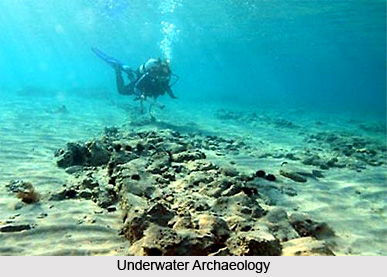 Underwater archaeology in India dates back to 1981 when the exploration of off shore sites furnished a number of intriguing artefacts. Interesting discoveries led to the popularity of this discipline throughout the country and revealed several concealed aspects of Indian history. Consequently, in the year 2001, the Archaeological Survey of India established the Underwater Archaeology Wing (UAW) to make further developments in this arena. Numerous studies have been conducted by UAW since its establishment, in Bay of Bengal and Arabian Sea. Underwater Archaeology Wing is involved in various activities such as documentation of ancient shipwrecks and underwater sites, imparting training to the professionals, conducting seminars pertaining to underwater archaeology, creating awareness among people and conserving the sunken ancient heritage of India. For exploring and preserving the cultural heritage of the country the wing often collaborates with other government organizations, like Indian Navy, to execute several projects.
Underwater archaeology in India dates back to 1981 when the exploration of off shore sites furnished a number of intriguing artefacts. Interesting discoveries led to the popularity of this discipline throughout the country and revealed several concealed aspects of Indian history. Consequently, in the year 2001, the Archaeological Survey of India established the Underwater Archaeology Wing (UAW) to make further developments in this arena. Numerous studies have been conducted by UAW since its establishment, in Bay of Bengal and Arabian Sea. Underwater Archaeology Wing is involved in various activities such as documentation of ancient shipwrecks and underwater sites, imparting training to the professionals, conducting seminars pertaining to underwater archaeology, creating awareness among people and conserving the sunken ancient heritage of India. For exploring and preserving the cultural heritage of the country the wing often collaborates with other government organizations, like Indian Navy, to execute several projects.
History of Underwater Archaeology in India
Significance of underwater archaeology in India became prominent long back and was acknowledged in the 6th five year plan. The history of the development of Underwater Archaeology Wing in Archaeological Survey of India has undergone through three phases. The first phase continued from 1987 to 1990. During this phase financial assistance was provided for the development of the wing. It also included conduction of seminars. In the year 1988 an archaeologist was sent for the first time to receive training in this multidisciplinary branch of archaeology. The trained archaeologists were then sent to work with the experts throughout the world to polish their skills in this new field. The second phase of its history continued from 1991 to 2000. During this time funded training programs were held till 1993, which were organized along with GSI and Andhra University. These were organized with aim of providing advanced training to the staffs. The first independent investigation was carried out in 1991 up to a depth of 40 metres in Indian waters. Till the excavation of 2002, it was regarded as the deepest underwater archaeological site. The third phase began from the year 2001 with the foundation of Underwater Archaeology Wing (UAW) on 8th February 2001. The wing started to function at the office of Director-General, Archaeological Survey of India at Janpath, New Delhi from 26th February 2001. Since its development UAW has conducted explorations at various sites including Mahabalipuram, Arikamedu, Elephanta Island and many more.
Underwater Archaeological Sites in India
The first offshore exploration was conducted by UAW in Bay of Bengal near Mahabalipuram in November 2001. In the excavation, the coastal areas from Sadrungpattnam in the south to Saluvankuppam in the north were explored. The next site explored was offshore and onshore sites of Elephanta Island which led to the documentation of several important historical remains. Evidences of maritime trade in ancient India were also found. Next exploration was done in Bay of Bengal in collaboration with Indian Navy to search for ancient sites and shipwrecks. In this project, a survey ship, known as INS Darshak, conducted the archaeological activities at the coasts of Arikamedu, Puducherry, Kaveripattinam etc. A number of shipwrecks were also located among which the shipwreck of Princes Royal in Lakshadweep waters was a significant one. The antiquities obtained from the wreckage included copper objects, glazed pottery, iron cannon and nails.



















